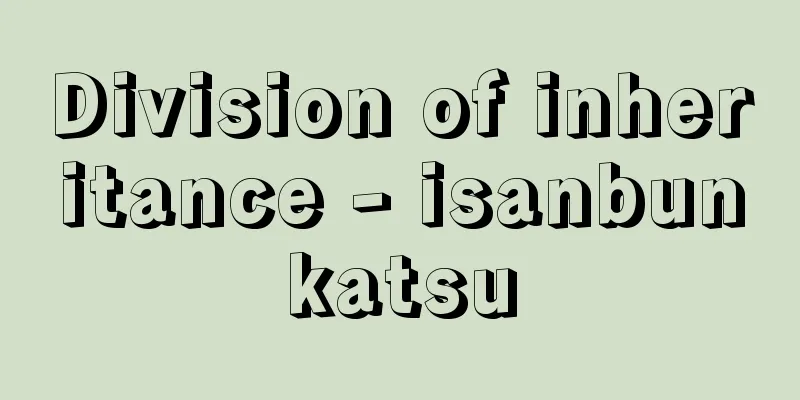Division of inheritance - isanbunkatsu

|
The distribution of the estate according to the specific share of each co-heir. In the case of co-heirs with two or more heirs, the estate will belong to each person according to their share as soon as the inheritance begins, but since it is practically impossible to divide it among the heirs immediately, the estate will be in the form of joint ownership (or inclusion), and the specific distribution method to each heir will be decided later. The method can be designated by the deceased in his will or entrusted to a third party (Civil Code Article 908), but if there is no will, it will be decided through consultation between the heirs. If the discussion does not reach an agreement, a request for division will be made to the family court (Civil Code Article 907). However, division can be prohibited for a specified period by the will of the deceased, a special agreement between the co-heirs, or a ruling by the family court (Civil Code Articles 907, Paragraph 3 and 908). When dividing an estate, it is necessary to strike a good balance between two requirements: to minimize the economic value of the estate as a whole, and at the same time to distribute it fairly to each heir. To this end, it is necessary to take into consideration the type and nature of the objects and rights belonging to the estate, the occupation of each heir, and all other circumstances (Article 906 of the same law). Therefore, it is not necessary to actually divide each piece of property, but to divide it according to the share of inheritance based on the appraised value. However, if there is a person (special beneficiary) among the joint heirs who received a bequest or gift during the deceased's lifetime from the deceased, it would be unfair if that person also received the statutory share of the inheritance through the division of the estate. Therefore, in such a case, the special beneficiary's share is added to the inherited property and the estate is divided (Article 903, Paragraph 1 of the same law). This is called the carry-back of the special beneficiary. However, if the deceased expressed an intention to be exempt from carry-back in a will or other document, the carry-back does not have to be carried back (Article 903, Paragraph 3 of the same law). Therefore, the 2018 (Heisei 30) revision of the inheritance law took the following measures to protect spouses. That is, if one of the deceased, who is a married couple with a period of marriage of 20 years or more, bequeaths or donates his or her residential building or its land to the other spouse, it is presumed that the intention to be exempt from carry-back was expressed (Article 903, Paragraph 4 of the same law), and the value of the residential real estate in question can be calculated without being treated as a special beneficiary when dividing the estate. In addition, a system was created that allows inherited savings and deposits to be repaid even before the division of the estate in order to meet financial needs such as the payment of living expenses, funeral expenses, and repayment of inherited debts (Article 909-2 of the same law). Also, if one of the joint heirs disposes of property belonging to the estate before the division of the estate, the disposed property can be included in the division of the estate with the consent of all the joint heirs (Article 906-2 of the same law), correcting unfairness that arises in the calculation. [Yasuyuki Takahashi and Masamitsu Nozawa, July 19, 2019] [Reference] | |Source: Shogakukan Encyclopedia Nipponica About Encyclopedia Nipponica Information | Legend |
|
遺産を各共同相続人の具体的な相続分に応じて分配すること。相続人が2人以上いる共同相続の場合、遺産は、相続開始と同時に相続分に応じて各人に帰属することになるが、これをすぐに相続人の間で分けることは実際には不可能であるから、共有(あるいは含有)の形にしておき、あとで各相続人にどのように分配するかを具体的に決めることになる。その方法は、被相続人が遺言(いごん)で自ら指定し、または指定を第三者に委託することができるが(民法908条)、とくに遺言がなければ、相続人同士の協議のうえで決める。協議が調わないときは家庭裁判所に分割の請求をすることになる(同法907条)。ただし、被相続人の遺言、共同相続人の特約、家庭裁判所の審判により、期間を定めて、分割を禁止することができる(同法907条3項、908条)。 分割にあたっては、遺産が一体としてもつ経済的価値をなるべく損なわず、同時に各相続人にこれを適正に配分するという二つの要求をうまく調和させることが要求される。このためには、遺産に属する物や権利の種類・性質、各相続人の職業、その他いっさいの事情を考慮に入れなければならないとされている(同法906条)。したがって、個々の財産をそれぞれ実際に分割する必要はなく、評価額のうえで相続分に応じた分け方をすればよい。 ところで、共同相続人のなかに、被相続人から、遺贈や生前贈与を受けた者(特別受益者)がいる場合に、その者がさらに遺産分割によって法定相続分の遺産を受け取ると不公平が生じる。それゆえ、このような場合には、その特別受益分を相続財産に加算して遺産分割を行うこととなる(同法903条1項)。これを、特別受益の持戻しという。ただし、被相続人が遺言などで、持戻し免除の意思表示を行っていた場合には、それに従い、持戻しは行わなくてもよい(同法903条3項)。そこで、2018年(平成30)の相続法改正では、配偶者を保護するために、次のような方策を講じた。すなわち、婚姻期間が20年以上の夫婦の一方である被相続人が、他方配偶者に対し、その居住用建物またはその敷地を遺贈または贈与した場合には、持戻しの免除の意思表示があったものと推定し(同法903条4項)、遺産分割において、当該居住用不動産の価額を特別受益として扱わずに計算をすることができることにした。このほか、相続された預貯金債権について、生活費や葬儀費用の支払い、相続債務の弁済などの資金需要に対応できるよう、遺産分割前にも払戻しが受けられる制度が創設された(同法909条の2)。また、共同相続人の一人が遺産分割前に遺産に属する財産を処分した場合にも、共同相続人全員の同意により、当該処分された財産を遺産分割の対象に含めることができることとし(同法906条の2)、計算上生じる不公平が是正されている。 [高橋康之・野澤正充 2019年7月19日] [参照項目] | |出典 小学館 日本大百科全書(ニッポニカ)日本大百科全書(ニッポニカ)について 情報 | 凡例 |
Recommend
Affordance - Affordance
A concept proposed by James Jerome Gibson (1904-1...
current mode logic
...Emitter-coupled logic circuit) A typical high-...
Shrub - Kanboku
〘 noun 〙 A woody plant that is short and has an un...
Palace style poetry - Kyūtaishi
This is a new style of poetry that was written by ...
Kusatsu [Hot Springs] - Kusatsu
...The maximum output per hot spring is about 40,...
Callaeas cinerea (English spelling) Callaeas cinerea
...It lives in forests, but its flying ability ha...
Crabbe, B. (English spelling) CrabbeB
...The serials of the 1930s and 40s were action-p...
False negative rate
...If the cytology test results in class III, IV,...
Salt wholesaler on the way down the river - Kaisenkudari Shiodoiya
…In addition, the Nakamura family, a brewer in Sh...
Thimble - Sashinuki
〘Noun〙① A type of hakama. A long, loose pair of ei...
Kawara Senbei - Kawara Senbei
[Confectionery] The university brand of Ritsumeika...
poktapok
...Such endurance sports, as typified by seal-pok...
Ibrahim (Aghlab) - Ibrahim
...Its capital was Kairawan. Its origins date bac...
Kyomodori - Returning today
…A marine fish of the family Grouper in the order...
Kazura (vine) - Kazura
A general term for vines. Examples include club vi...









